This week’s FreightWaves Supply Chain Pricing Power Index: 35 (Shippers)
Last week’s FreightWaves Supply Chain Pricing Power Index: 35 (Shippers)
Three-month FreightWaves Supply Chain Pricing Power Index Outlook: 40 (Shippers)
The FreightWaves Supply Chain Pricing Power Index uses the analytics and data in FreightWaves SONAR to analyze the market and estimate the negotiating power for rates between shippers and carriers.
This week’s Pricing Power Index is based on the following indicators:
Volumes remain under pressure, but time sensitivity should pick up in the coming weeks
The first half of November has been challenging from a volume perspective as the freight market has continued to see volume levels decline from their early September peak. The intermodal market has provided a relief valve for the market, especially domestic intermodal, which has seen volumes continue to rise in a period of time that is at the tail end of the traditional peak season.
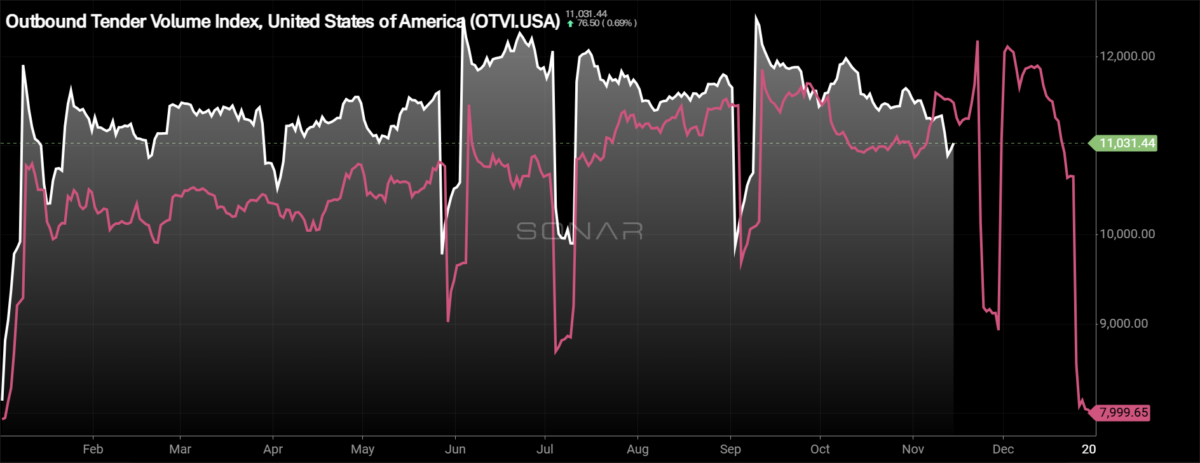
To learn more about FreightWaves SONAR, click here.
The Outbound Tender Volume Index (OTVI), a measure of national freight demand that tracks shippers’ requests for trucking capacity, accelerated its decline this week, falling by 2.24%. The OTVI has remained down on a year-over-year basis, currently down 1.87%.
Across the various mileage bands, volumes were challenged this week, with the exception of loads moving between 100 and 250 miles. The short-haul volumes increased by 0.63% w/w, while long-haul volumes, loads moving more than 800 miles, declined by 3.62% w/w.
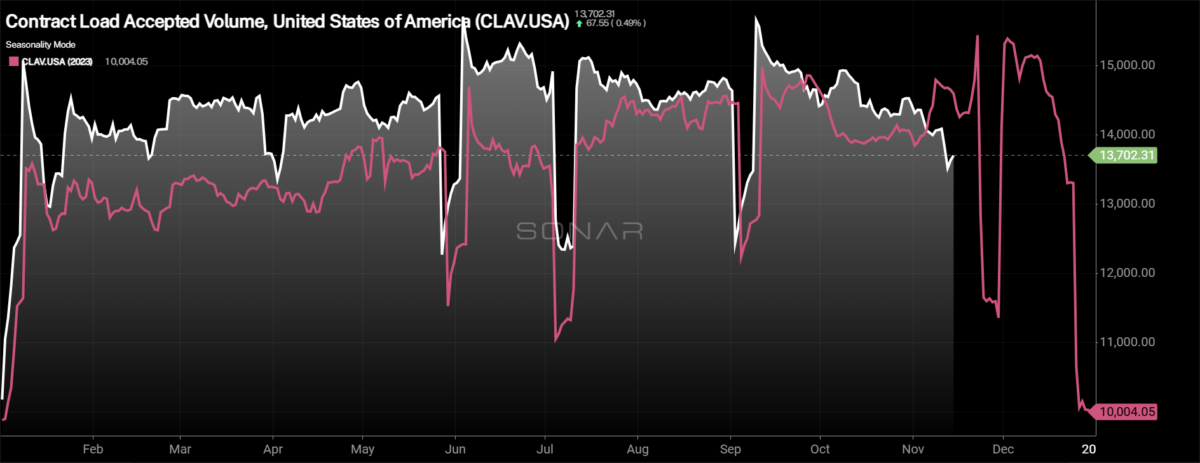
To learn more about FreightWaves SONAR, click here.
Contract Load Accepted Volume (CLAV) is an index that measures accepted load volumes moving under contracted agreements. In short, it is similar to OTVI but without the rejected tenders. Looking at accepted tender volumes, the decline was slightly smaller than the decline in OTVI, falling 2.1% w/w, thanks in large part to a decline in rejection rates. With the impact of tender rejection rates in mind, CLAV is down 3.89% y/y, as tender rejection rates are up by nearly 200 basis points compared to this time last year.
Spending in October was stronger than expected as retail sales bested analysts’ estimates, rising 0.4% month over month, compared to the 0.3% estimates. Retail sales were up 2.8% y/y, and excluding gas station spending, retail sales were 3.7% higher y/y. Electronics spending was a strength in October, rising 2.3% m/m. This echoes sentiment from Bank of America’s recent card spending report in which online electronic sales were up double digits y/y in the final week of October but have since fallen off in November.
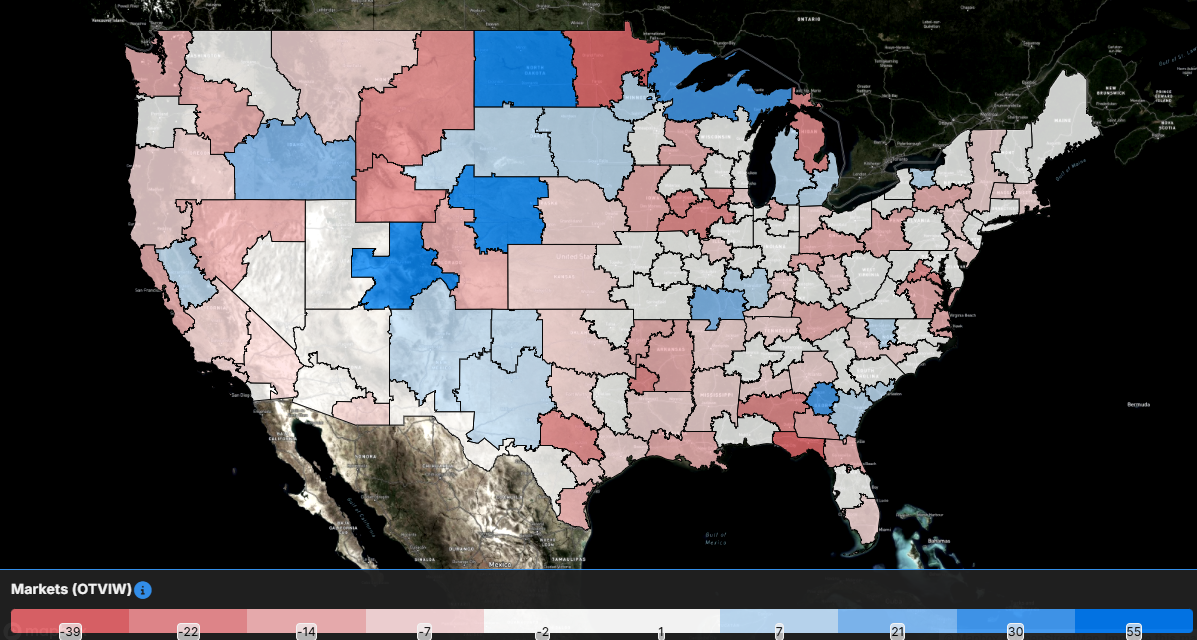
To learn more about FreightWaves SONAR, click here.
As tender volumes have continued their decline, it is being experienced by the majority of freight markets across the country. Of the 135 freight markets tracked within SONAR, 55 markets experienced volume growth over the past week, up from 50 in last week’s report.
The gains in tender volumes this week were largely driven by growth in some of the smallest freight markets in the country across the mountain prairie region, with the largest increase in the country happening in Bismarck, North Dakota. Since these markets are small in terms of outbound volume, they can have large weekly percentage changes in outbound volume.
Now, the Midwest had a fairly strong week in terms of outbound volume. One of the largest markets in the region, Joliet, Illinois, saw outbound volumes grow by 4.3% over the past week. The market and region as a whole are likely being aided by strong intermodal demand from Los Angeles to Chicago, which was up 4.3% over the past week.
The largest market in the country by outbound volume, Ontario, California, took a breather this week as tender volumes out of the market dropped by nearly 4% w/w.
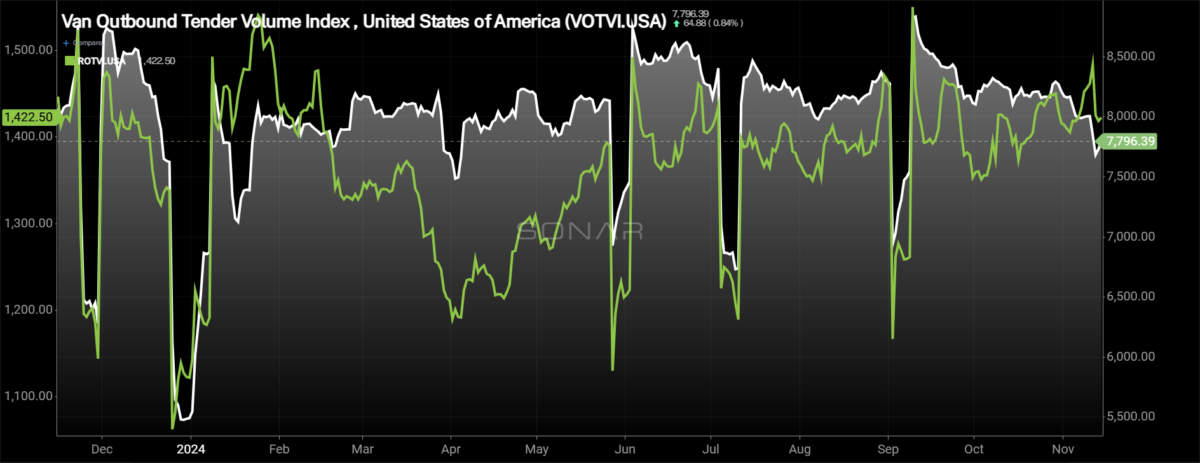
To learn more about FreightWaves SONAR, click here.
By mode: The dry van market continued to see weakness this week, falling to nearly the lowest level of the year. This week did see a drop right around Veterans Day, which tends to not be too impactful to freight volumes, but the Van Outbound Tender Volume Index did fall by 2.4% w/w. Dry van volumes are down 2.77% y/y, again highlighting the challenges that the market is feeling at the moment.
The reefer market took a breather this week but remains above where it was this time last year. The Reefer Outbound Tender Volume Index fell by 0.8% over the past week, but the longer-term trend is for reefer volumes moving higher. Reefer volumes are up 0.67% y/y.
Rejection rates dip below 6%, remain elevated ahead of peak
Rejection rates gave back some of the recent gains this week, but the market continues to show signs that it is tightening. The gains in recent weeks have occurred ahead of what traditionally happens before Thanksgiving, but the recent uptick sets the stage for the market to face disruption during the holidays that hasn’t been felt in more than two years.
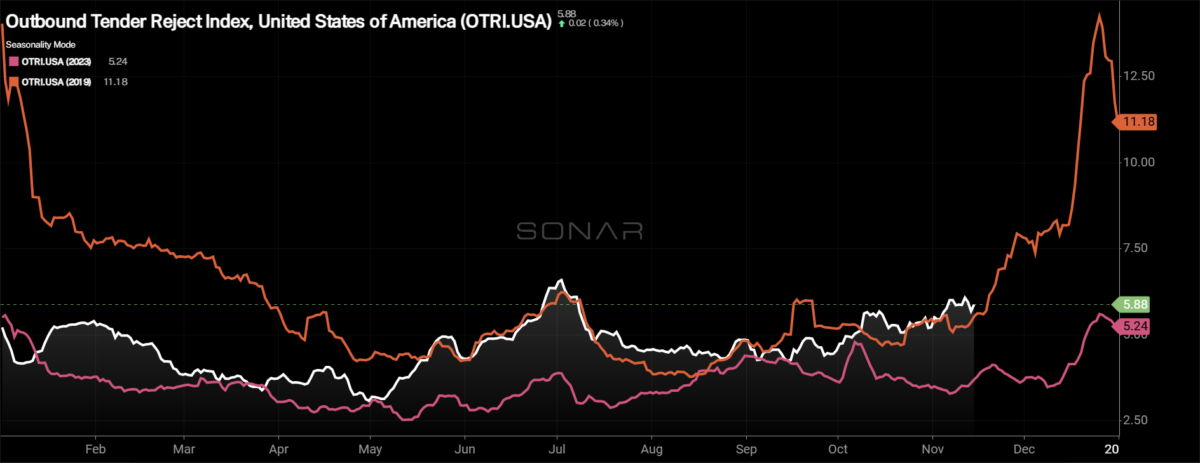
To learn more about FreightWaves SONAR, click here.
Over the past week, the Outbound Tender Reject Index (OTRI), a measure of relative capacity, fell by 13 basis points, falling back under 6% and now sitting at 5.88%. At present, the OTRI is 198 bps higher than it was this time last year and 35 bps higher than it was in 2019. If the market follows the traditional pattern, there will be another uptick in tender rejection rates in the middle of this week as the Thanksgiving holiday is just over a week away.
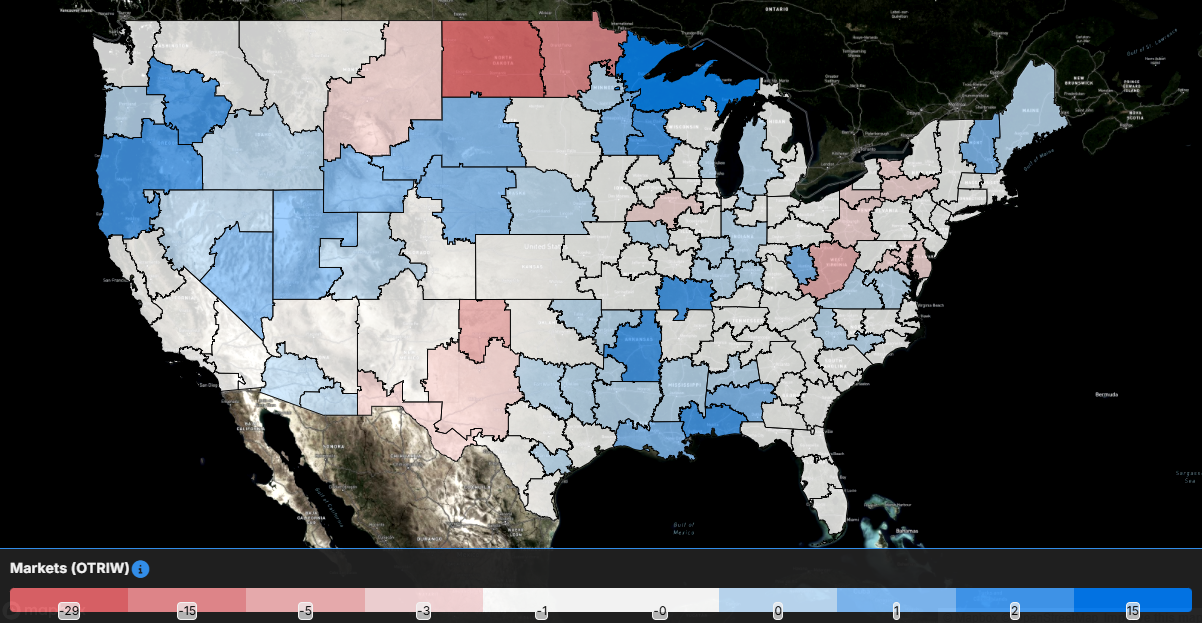
To learn more about FreightWaves SONAR, click here.
The map above shows the Outbound Tender Reject Index — Weekly Change for the 135 markets across the country. Markets shaded in blue and white are those where tender rejection rates have increased over the past week, whereas those in red have seen rejection rates decline. The bolder the color, the more significant the change.
Of the 135 markets, 64 reported higher rejection rates over the past week, down from the 97 that saw tender rejection rates rise in last week’s report.
The markets that are struggling with capacity, where tender rejection rates are rising over the past week, have been predominantly in the Pacific Northwest as well as smaller freight markets across the country. Pendleton and Medford, Oregon, experienced two of the three largest increases in rejection rates in the country over the past week. Tender rejection rates increased by 367 and 338 bps, respectively, over the past week.
Tender rejection rates in the largest freight markets were slightly lower over the past week, falling by 16 bps in both Ontario and Atlanta.
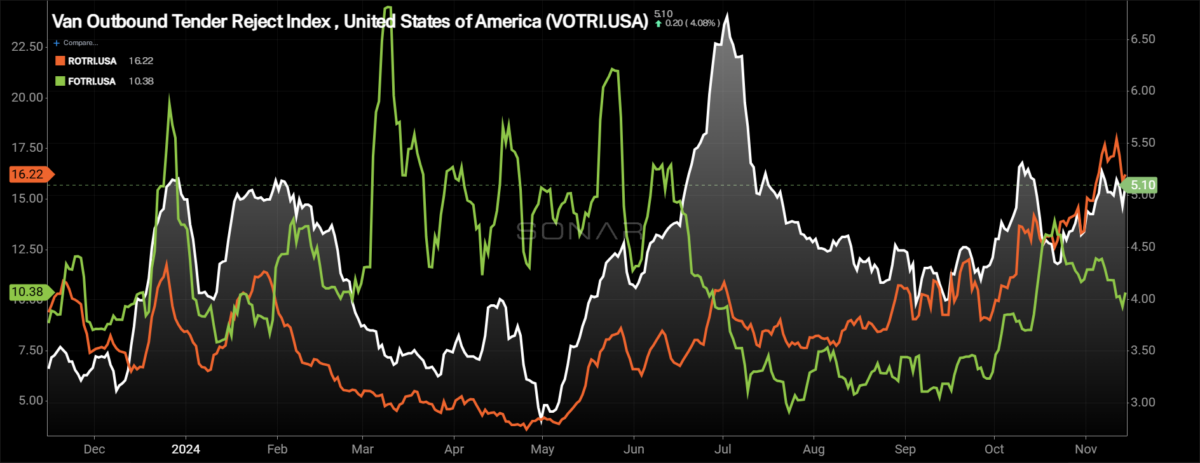
To learn more about FreightWaves SONAR, click here.
By mode: The dry van market continues to lag behind the other two equipment types within SONAR, but the market was fairly stable this week. The Van Outbound Tender Reject Index fell by just 5 basis points over the past week to 5.1%. Dry van tender rejection rates are 166 bps higher than they were this time last year.
As the reefer market has continued to tighten throughout the back half of the year, the market has faced some volatility. The Reefer Outbound Tender Reject Index fell by 130 basis points over the past week but still sits at 16.22%. At 16.22%, reefer tender rejection rates are below their long-term average but are more than double what they have averaged since April 2022. The national reefer tender rejection rate is 650 bps higher than it was this time last year.
Two hurricanes making landfall in Florida and impacting the Southeast as a whole provided a much-needed shot in the arm for the flatbed market, where tender rejections were at the lowest level of the year ahead of the storms. As relief efforts are still ongoing, flatbed rejection rates remain elevated from where they were in August and September but have retreated from recent highs. The Flatbed Outbound Tender Reject Index fell by 121 basis points over the past week to 10.38%. The flatbed tender rejection rate continues to hold on to y/y gains, currently 91 bps higher.
Spot rates rise but at a slower pace than in recent weeks
Despite tender rejection rates taking a breather this week, spot rates have continued to react positively as the market heads to peak season. Spot rates have been trending higher in aggregate for the past year, but that isn’t without some volatility along the way. The upward trend in recent weeks helps set carriers up to capture even more positive momentum throughout the holiday season.
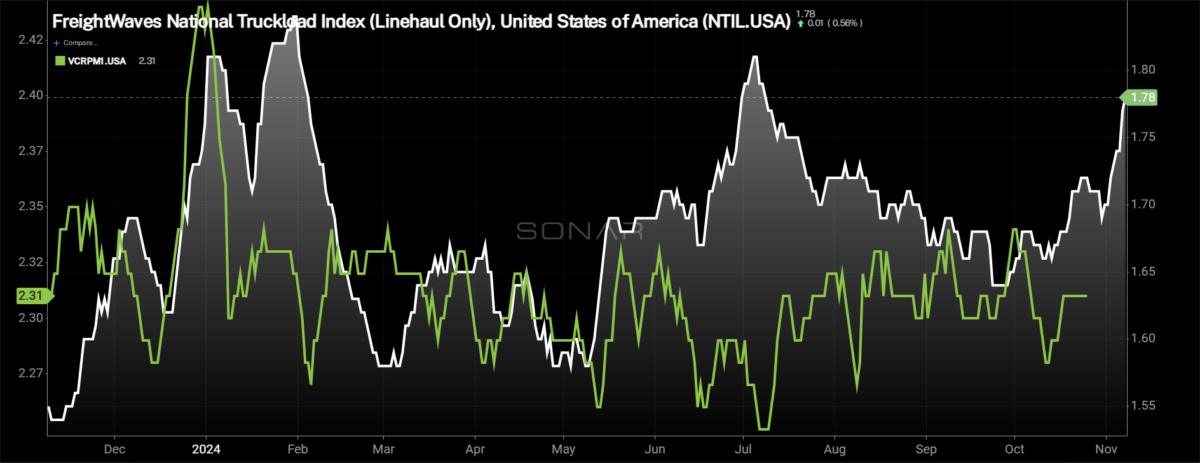
To learn more about FreightWaves SONAR, click here.
This week, the National Truckload Index — which includes fuel surcharge and various accessorials — saw a more modest increase, rising by 1 cent per mile, following last week’s 9-cent-per-mile increase, to $2.35 per mile. With the increase, the NTI is now widening the gap with last year’s figure, now 12 cents per mile higher y/y. The linehaul variant of the NTI (NTIL) — which excludes fuel surcharges and other accessorials — increased slightly more than the NTI, signaling that a decline in fuel costs was again deflationary to all-in spot rates. The NTIL rose by 2 cents per mile to $1.80. The NTIL is 25 cents per mile higher than it was this time last year, a sign of how impactful the decline in diesel fuel prices has been as a rate deflator for all-in spot rates. The average diesel price at truck stops is down 17.8% compared to this time last year. Heading into 2025, rapid changes in diesel fuel prices could have a fairly sizable impact on rates.
Initially reported dry van contract rates, which exclude fuel, have remained fairly stable the past couple of months, as shippers have become more understanding over the past year that pricing could shift significantly. Over the past week, the initially reported dry van contract rate increased by 2 cents per mile to $2.33. Initially reported dry van contract rates are 3 cents per mile higher than they were this time last year.
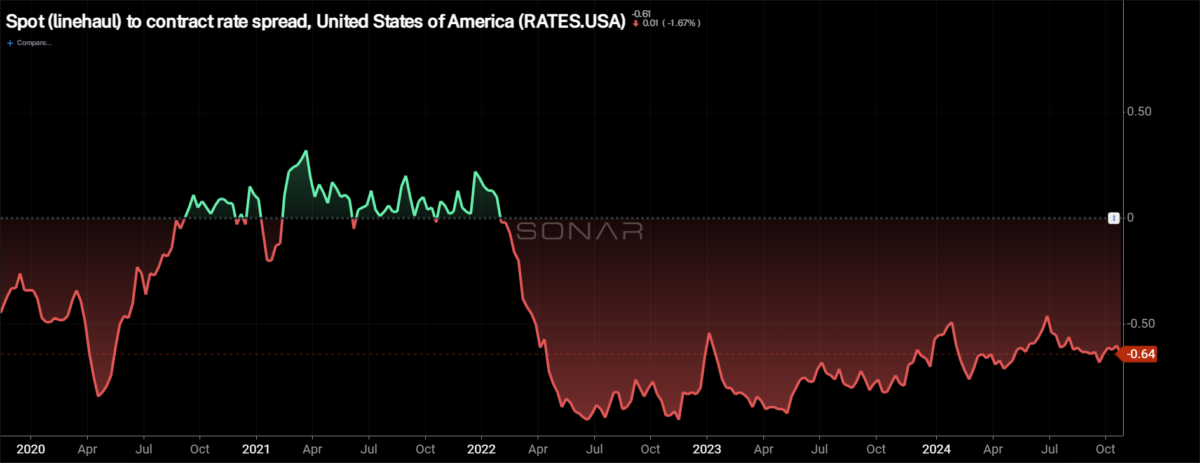
To learn more about FreightWaves SONAR, click here.
The chart above shows the spread between the NTIL and dry van contract rates is trending back to pre-pandemic levels. The spread remains wide, but with the recent positive momentum in spot rates and flattening of contract rates, the spread is narrowing over the long term. Over the past week, the spread between contract and spot rates widened by 4 cents per mile, and it is 12 cents narrower than it was this time last year.
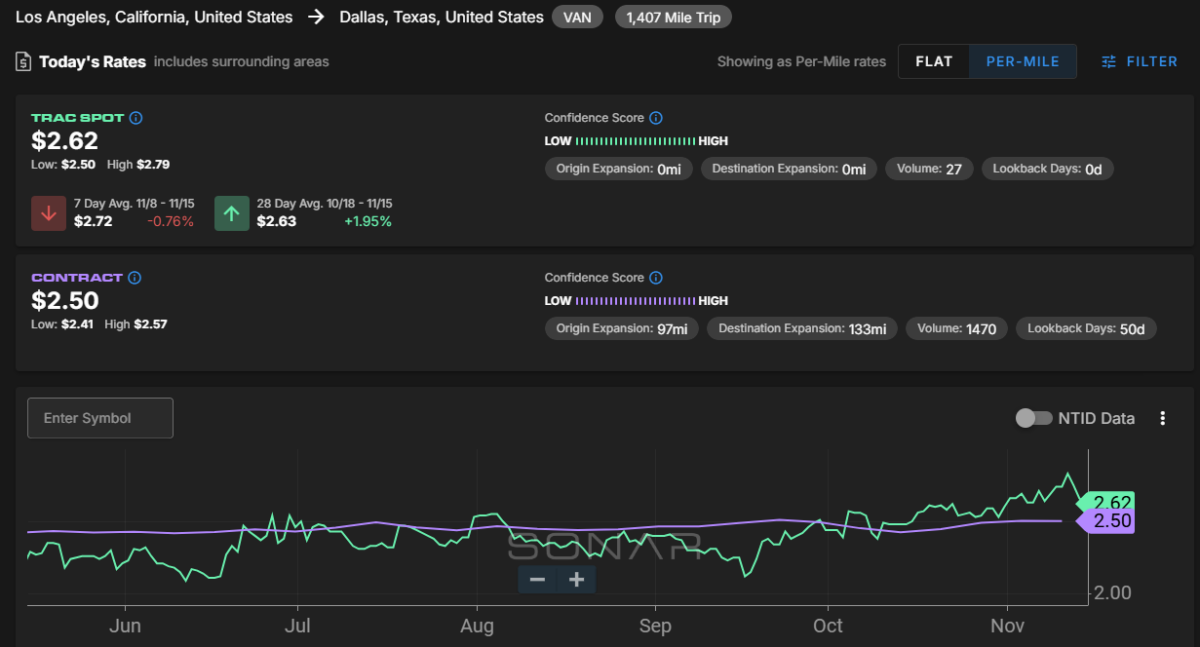
To learn more about FreightWaves TRAC, click here.
The FreightWaves Trusted Rate Assessment Consortium spot rate from Los Angeles to Dallas continues to trend higher, but not without some volatility along the way. The TRAC rate from Los Angeles to Dallas decreased by 2 cents per mile to $2.62. Spot rates along this lane are 12 cents per mile above the contract at present.
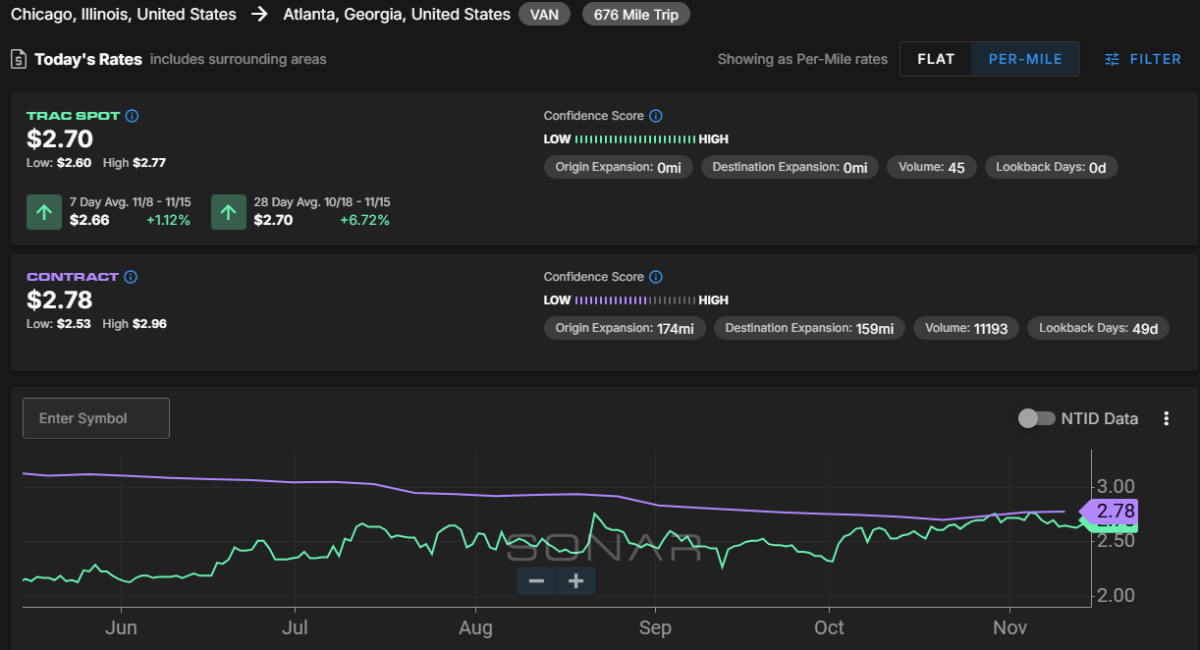
To learn more about FreightWaves TRAC, click here.
From Chicago to Atlanta, spot rates have been volatile but really haven’t moved significantly since the beginning of the month. The TRAC rate for this lane rose by 3 cents per mile over the past week to $2.70, after declining 5 cents per mile in last week’s report. Spot rates are 8 cents per mile below the contract rate, but that spread is as narrow as it has been all year.







